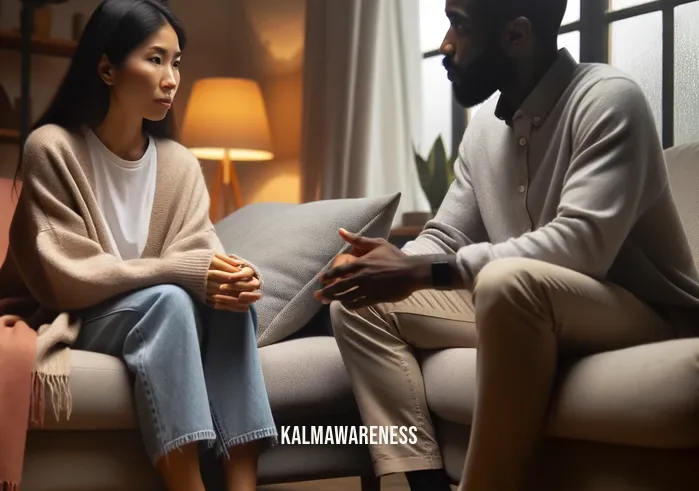Embracing the Discomfort: Navigating Through Unfamiliar Emotional Territories
Understanding the Terrain of Uncomfortable Feelings
Have you ever felt like you’re on an emotional rollercoaster, unsure of how to deal with the highs and lows? You’re not alone. Navigating uncomfortable feelings is akin to traversing a complex maze without a map. It’s normal to feel a mix of emotions like anxiety, sadness, or frustration. However, it’s crucial to recognize that these feelings are not permanent fixtures in our lives. Just as clouds pass in the sky, so do our emotional states.
The Nature of Uncomfortable Emotions
Uncomfortable feelings often arise as natural responses to life’s challenges. They might be triggered by events, memories, or even anticipations of future occurrences. It’s important to remember that these emotions are part of being human; they’re not flaws or weaknesses. Understanding their transient nature helps us approach them with a kinder, more accepting mindset.
Why We Avoid Uncomfortable Feelings
So, why do we often find ourselves trying to push these feelings away? It’s a defense mechanism. Our brains are wired to seek comfort and avoid pain. But this avoidance can lead to a cycle of emotional suppression, which paradoxically intensifies these feelings over time. By learning how to sit with uncomfortable feelings, we can break this cycle.
The First Steps in Sitting with Discomfort
Acknowledging and Naming Emotions
The first step in sitting with discomfort is acknowledging it. Recognize what you’re feeling without judgment. Are you feeling anxious, sad, or angry? Naming your emotions is a powerful tool in understanding them better. This simple act of acknowledgement is a form of validation, reassuring yourself that it’s okay to feel this way.
Breathing Through the Discomfort
Breathwork can be a valuable ally in managing uncomfortable emotions. Deep, mindful breathing has a calming effect on the nervous system, creating a space between you and your emotions. It doesn’t eliminate the discomfort, but it makes it more manageable. Engaging in practices like mindful breathing can significantly aid in this process.
Cultivating a Non-Judgmental Attitude
Developing a non-judgmental attitude towards your feelings is essential. This means observing your emotions without labeling them as good or bad. It’s about accepting them as they are. This acceptance is the foundation for emotional resilience and mental well-being.
Embracing Mindfulness and Self-Compassion
Mindfulness: The Art of Presence
Mindfulness is about being present in the moment, fully experiencing your emotions without getting overwhelmed by them. It involves a conscious effort to stay grounded, observing your feelings with curiosity and openness. This practice can be enhanced through guided mindfulness exercises.
Self-Compassion: Being Your Own Ally
Self-compassion is treating yourself with the same kindness and understanding that you would offer a good friend. It involves recognizing that experiencing uncomfortable feelings is a shared human experience. This perspective helps in reducing the isolation and self-criticism that often accompany such emotions.
Conclusion: Setting the Stage for Growth
Sitting with uncomfortable feelings is not about finding immediate solutions or making the feelings vanish. It’s about developing a compassionate and understanding relationship with your emotions. This process paves the way for personal growth and emotional maturity.
As we wrap up this section, ponder this question: What if, instead of viewing uncomfortable feelings as obstacles, we saw them as opportunities for growth and self-discovery? Stay tuned for the next part where we delve deeper into turning discomfort into a catalyst for change.

Transforming Discomfort into Insight: A Deeper Dive
The Role of Emotional Intelligence in Managing Discomfort
Expanding from our initial exploration of uncomfortable feelings, let’s delve into the role emotional intelligence plays in this journey. Emotional intelligence involves not only recognizing and naming our emotions but also understanding and managing them effectively. It’s a skill that enhances our ability to sit with discomfort, allowing us to respond rather than react to our feelings.
Developing Emotional Awareness
Building emotional awareness is key. It’s about tuning into your feelings with curiosity and openness. Ask yourself: What am I feeling right now? What triggered this emotion? Understanding the ‘why’ behind your feelings can be enlightening.
Managing Emotional Responses
Once you’re aware of your emotions, the next step is managing them. This doesn’t mean controlling or suppressing them but rather allowing them to be, without letting them overpower you. Techniques like mindfulness and meditation can be highly effective in this stage.
Strategies for Sitting with Uncomfortable Feelings
Reframing Your Perspective
Reframing involves changing your viewpoint on uncomfortable feelings. Instead of seeing them as negative, view them as signals or messages. What are they trying to tell you? This shift in perspective can be a powerful tool in understanding and embracing these emotions.
Practicing Patience and Persistence
Sitting with discomfort requires patience. It’s not a skill mastered overnight but a practice that develops over time. Be persistent in your efforts, and remember that it’s a journey of gradual progress.
Utilizing Mindful Techniques
Mindfulness and Meditation
Mindfulness and meditation are not just about stillness and quiet; they are active practices of observing your thoughts and feelings without judgment. Regular practice can significantly improve your ability to sit with discomfort.
Table: Mindful Practices for Managing Discomfort
| Practice | Description | Benefit |
|---|---|---|
| Focused Breathing | Concentrating on your breath to stay present | Calms the mind and centers thoughts |
| Body Scanning | Observing sensations throughout your body | Increases bodily awareness and relaxation |
| Guided Meditation | Following a structured meditation narrative | Helps in cultivating a focused and clear mind |
The Power of Support Systems
Seeking Guidance and Community
Sometimes, sitting with discomfort can be overwhelming. This is where support systems come into play. Seeking guidance from professionals or joining community groups can provide the encouragement and insight needed to navigate these feelings.
The Role of Therapy and Counseling
Therapy and counseling are invaluable resources in learning how to sit with uncomfortable feelings. These spaces offer a safe environment to explore and understand your emotions deeply, guided by trained professionals.
Conclusion: Preparing for Continuous Growth
As we further understand and practice these strategies, our capacity to sit with uncomfortable feelings grows. Remember, this journey is about continuous growth and learning. Each experience, each moment of discomfort, is an opportunity to develop a deeper understanding of ourselves.
In the final section, we’ll explore how embracing discomfort can lead to personal growth and transformation. Before we get there, consider this: How might embracing your uncomfortable feelings change the way you approach challenges and uncertainties in life? Stay tuned for insights that will tie together our exploration of this profound journey.

Harnessing Growth from Uncomfortable Feelings
The Journey of Emotional Mastery
As we conclude our exploration of how to sit with uncomfortable feelings, it’s essential to recognize this process as a journey towards emotional mastery. It’s about transforming discomfort into a catalyst for growth and self-awareness. Let’s synthesize the insights gained and look at actionable ways to apply them in our daily lives.
Turning Insights into Actions
Every encounter with discomfort is an opportunity to practice the strategies we’ve discussed. It’s about taking the insights from our understanding and awareness and turning them into concrete actions. For example, when faced with a challenging emotion, pause, acknowledge it, use mindful breathing to center yourself, and then proceed with a response informed by self-compassion and emotional intelligence.
The Role of Continuous Practice
Remember, the ability to sit with uncomfortable feelings improves with practice. Like any skill, emotional resilience builds over time. It’s a gradual process that requires patience and persistence.
Future Applications in Daily Life
Personal Relationships
In personal relationships, being able to sit with discomfort can lead to more authentic and meaningful connections. It encourages open communication and a deeper understanding of oneself and others.
Professional Growth
In the workplace, this skill can enhance your ability to handle stress, conflict, and uncertainty, making you a more resilient and adaptable professional.
Overall Well-being
Embracing and managing uncomfortable feelings plays a crucial role in your overall mental and emotional well-being. It can lead to a more balanced, fulfilling life.
Encouraging Reader Participation and Reflection
- How will you apply these insights in your next encounter with uncomfortable emotions?
- Can you identify areas in your life where sitting with discomfort could lead to significant positive changes?
Summarizing Key Points
- Acknowledge and name your emotions to understand them better.
- Use mindful practices like breathing and meditation for emotional regulation (explore more on mindful practices).
- Cultivate patience and practice consistently for emotional resilience.
- Apply these skills in personal and professional contexts for meaningful growth.
Further Learning and Exploration
To deepen your understanding and skills, consider exploring additional resources. Books, articles, and courses on emotional intelligence, mindfulness, and personal development can provide valuable insights and tools. For instance, Jack Kornfield’s meditation guides offer practical wisdom for those seeking to deepen their meditation practice.
Conclusion: Embracing Life’s Emotional Spectrum
As we wrap up our journey on how to sit with uncomfortable feelings, remember that the essence of this practice is embracing life’s full emotional spectrum. It’s about finding strength in vulnerability and viewing every emotional experience as an opportunity for growth and self-discovery.
Consider this journey as a continuous process of learning and self-improvement. Each step you take in sitting with your discomfort is a step towards a more resilient, compassionate, and emotionally intelligent self.
Key Insights Summarized:
- Embracing discomfort is essential for emotional growth and self-awareness.
- Mindful practices are crucial tools for managing uncomfortable feelings.
- Continuous practice leads to improved emotional resilience.
- Applying these skills can enhance personal relationships, professional growth, and overall well-being.
As you move forward, let these insights guide you in transforming your uncomfortable feelings into opportunities for growth and self-discovery.



